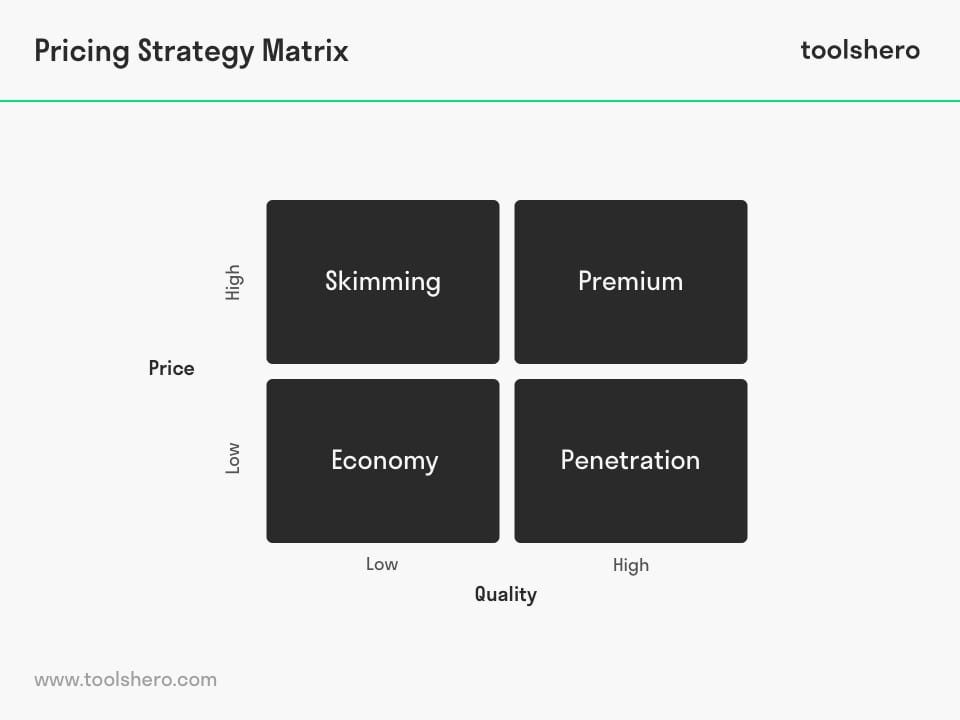Pricing Strategy Matrix

Pricing Strategy Matrix: this article provides a practical explanation of the pricing strategy matrix. After reading, you’ll understand the basics of this powerful strategy tool.
What is the Pricing Strategy Matrix?
The Pricing Strategy Matrix is a tool that’s used to determine the best price for a product or service. A pricing strategy refers to the method businesses use to decide the right price for their services or products.
Almost all organisations base their prices on the costs of production, labour, and marketing, to which they then add a certain percentage to make a profit. The main factor here is the COGS (Cost of Goods Sold).
Pricing strategies also take into account many business factors, such as turnover targets, target audience, brand positioning, product features, and marketing SMART goals.
In addition, prices are influenced by external factors, such as consumer demand for a specific product, competitor pricing, and the overall economic and market trends.
Price is part of the marketing mix, with many claiming price is the least appealing element.
The argument is that suppliers of products first have to look at the other aspects of the marketing mix, before focusing on price.
Price formation with the Pricing Strategy Matrix
Determining the right price for a product requires more consideration than just adding the costs of production. The real question when determining the right price is how much the customer is willing to pay for the product.
That price doesn’t have a lot to do with costs, while it has everything to do with the value the customers attach to the product or service. For a simple drink glass, the average consumer won’t spend more than a few euros. There are plenty of alternatives available, and if the price is too high, the consumer will choose a competitor.
In this case, playing with pricing is not something a producer can afford. However, if the product is an advanced smart pressure cooker, then the customer is probably willing to spend a little more. There’s less competition, so a well-made product that’s appreciated by the consumer can be sold at a high price.
Finding out what a product or service is worth to consumers and basing the price on that is called value-based pricing. This article discusses this form of pricing strategies, as well as a few others.
Price elasticity
Price elasticity is a measurement in economics that’s used to indicate how sensitive the demand for a product is if the price were to change. Price elasticity is indicated as a percentage change in the demand quantity for a product or service in response to a price change of one per cent.
Products are said to be inelastic when consumers continue to buy a product when the price goes up. Examples are cigarettes and petrol. If the product or service is elastic, that means the price change does affect demand for it. Examples of those are train tickets (public transport) and furniture.
Penetration pricing strategy
The quadrant on the bottom right in the Pricing Strategy Matrix represents penetration pricing. Penetration pricing is used by companies who offer a new product or service at a lower price after it’s first launched to get customers. The lower price will make it easier for a product or service to penetrate the market. The result of this strategy is that customers will leave the competition.
One example of such a strategy is an online news website that offers a one-month free trial subscription.
Pros of penetration pricing
- Lowering the entry threshold
- Reduced or weakened competition
- Market dominance
Cons of penetration pricing
- Not very effective on competitors with strong branding
- Loss of customers when prices are raised
- Potentially triggering a pricing war
Price skimming strategy
Price skimming is shown in the bottom left of the price strategy matrix. This strategy involves asking a high price from the consumer at the launch of a product or service. That means the first group of customers pays a high price for the good or service. After a while, the company lowers the prices in order to attract a different, more price-sensitive segment of the market.
Price skimming is used when a new product or service is introduced. The goal is to get as much revenue as possible. Once these financial targets have been achieved, the price is lowered to appeal to more cost-conscious consumers.
Pros of price skimming
- High profit margin
- Quickly earn back production costs
- Distributors earn a big profit because of the high price, making them very engaged
- Create a temporary sense of high quality
Cons of price skimming
- Competitors will also lower prices
- Limited sales volume
- Frustrated early customers because of the high initial price
- Not cost efficient
Competitive/economy pricing strategy
The economy or competitive pricing strategy is shown in the top left of the Pricing Strategy Matrix. This strategy involves basing the price of the product or service on the market. This method is used by companies that sell similar products.
The competitive pricing strategy is used when a price for a product or service has reached a balance. This often occurs when a product or service has been on the market for some time already, and there are many similar products or services available.
Companies have three options for this method: undercut the competition’s price, equal the competition’s price, or a higher price than the competition.
Pros of the economic pricing strategy
- Safe during times of economic instability
- Staying slightly below the competition’s price helps to gain a larger market share
Cons of the economic pricing strategy
- Smaller businesses might have trouble remaining profitable
- Customer loyalty has its limits in customers who are always looking for the best price
Premium pricing strategy
The final strategy from the matrix is premium pricing. This strategy refers to artificially keeping prices elevated to encourage consumers’ positive perception, based solely on price. Premium refers to a group of products or services that offer imagined or actual added value compared to competitors.
The strategy relies on buyers assuming that a high price automatically means exceptional quality. It’s used in segments where consumers are willing to pay a little more for a certain product.
Pros of premium pricing
- Competitive edge through branding and reputation
- Increased brand awareness
- Higher profits
Cons of premium pricing
- High marketing costs
- Limited customer base
Pricing Strategy Matrix summary
The Pricing Strategy Matrix helps organisation to determine the correct pricing for their products and services.
Many organisations base their prices on production and marketing costs, but there are other options that might have different results. Pricing is part of the marketing mix, which makes it an important consideration when launching a new product or service.
The Pricing Strategy Matrix shows the following for pricing strategies:
1. Penetration pricing strategy
This pricing strategy is used by organisations to appeal to part of the market by offering low prices.
By asking low prices for their products, they can steal a lot of customers from the competition. The downside of this strategy is that those new customers will leave when the price is raised again.
2. Price skimming strategy
Price skimming is when an organisation only asks a high price at the introduction of a product or service. There is a group of consumers who are willing to pay this high initial price.
It’s a way for the organisation to quickly generate a lot of turnover and earn back the manufacturing costs.
After a while, the organisation will lower the price to attract a different, more price-conscious group of potential customers. A downside of this strategy is that many early customers will become frustrated when they see how prices have dropped over time.
3. Competitive pricing strategy
The competitive or economy pricing strategy refers to determining the price based on supply and demand.
This strategy is often used for products and services that have been on the market for a while, and for which a lot of alternatives or substitutes are available.
Companies can choose to set prices below, exactly at, or slightly above the market price. This is a relatively safe strategy, though it can make it difficult for smaller businesses to make a profit.
4. Premium pricing strategy
The final strategy from the matrix is premium pricing. This strategy involves keeping prices high without this actually being based on production or marketing costs.
Premium refers to a group of products that consumers don’t mind paying a little more for. This can be the result of strong branding and marketing.
This is not a valid strategy for all organisations. One benefit of this strategy is high profit margins. The major downside is high marketing costs.
Now it’s your turn
What do you think? Do you recognise the explanation of the Pricing Strategy Matrix? What other pricing strategies do you know? Do you have a preferred pricing strategy for your goods or services? Which pricing strategies are employed by your favourite brands for different kinds of products? Do you have any tips or additional comments?
Share your experience and knowledge in the comments box below.
More information
- Cravens, D. W., & Piercy, N. (2006). Strategic marketing (Vol. 6). New York: McGraw-Hill.
- Duke, C. R. (1994). Matching appropriate pricing strategy with markets and objectives. Journal of Product & Brand Management, 3(2), 15-27.
- Krishnan, T. V., Bass, F. M., & Jain, D. C. (1999). Optimal pricing strategy for new products. Management Science, 45(12), 1650-1663.
- Theodosiou, M., & Katsikeas, C. S. (2001). Factors influencing the degree of international pricing strategy standardization of multinational corporations. Journal of International Marketing, 9(3), 1-18.
How to cite this article:
Janse, B. (2019). Pricing Strategy Matrix. Retrieved [insert date] from Toolshero: https://www.toolshero.com/marketing/pricing-strategy-matrix/
Original publication date: 10/09/2019 | Last update: 07/30/2023
Add a link to this page on your website:
<a href=”https://www.toolshero.com/marketing/pricing-strategy-matrix/”>Toolshero: Pricing Strategy Matrix</a>







